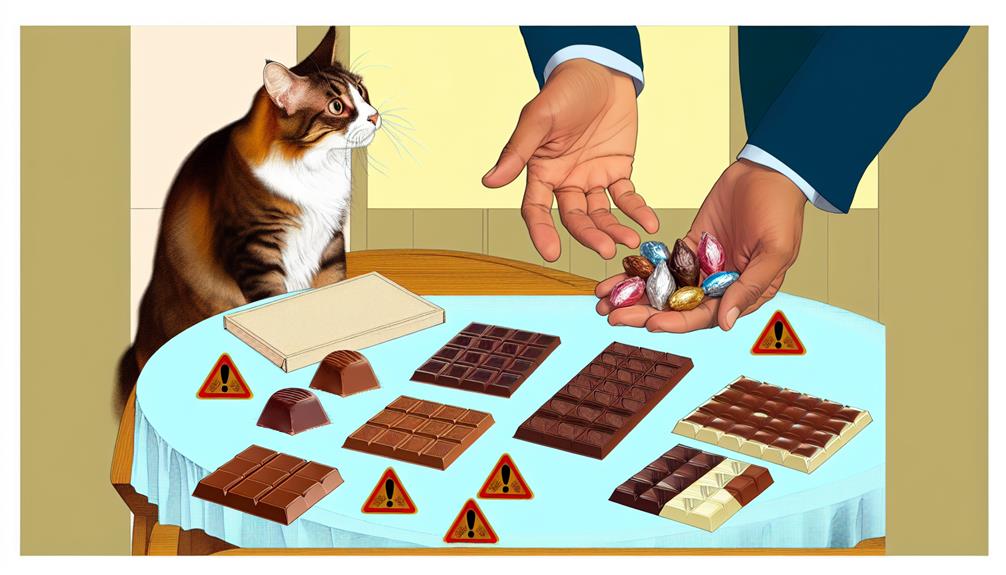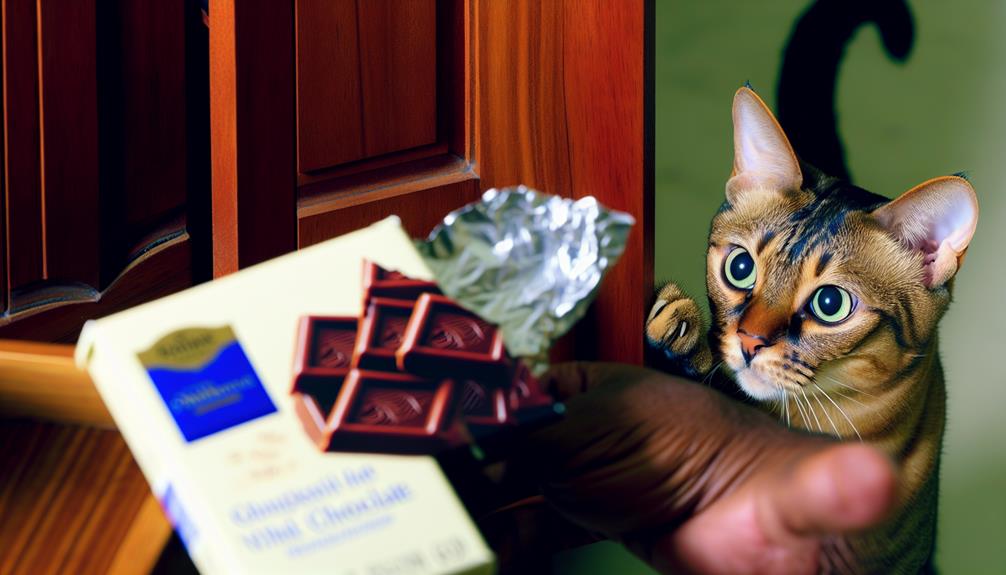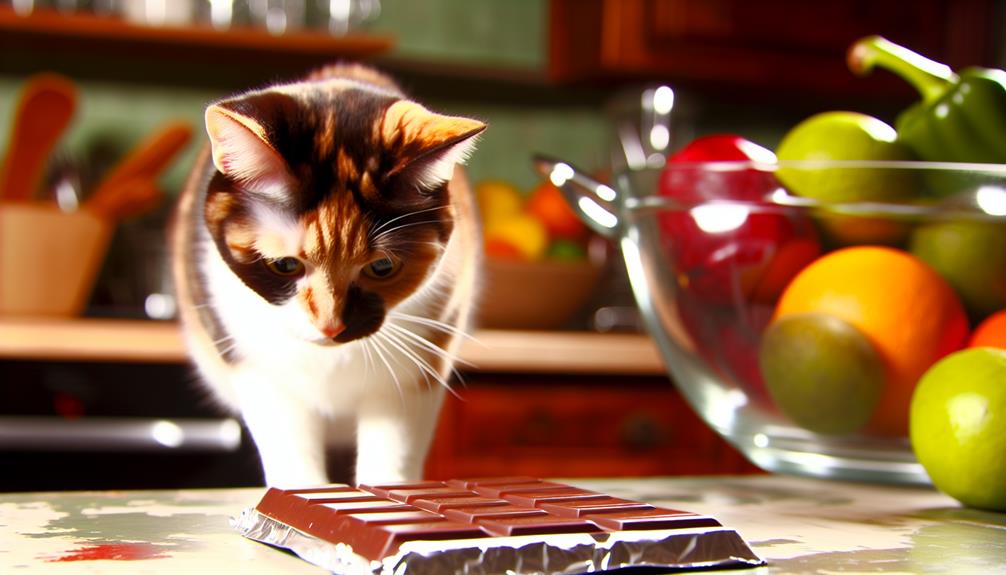Just like the forbidden fruit in Eden, chocolate is a tempting treat that can spell disaster for your feline friend. Cats should never eat chocolate due to the toxic components it contains, such as theobromine and caffeine. Even a small amount can lead to vomiting, seizures, and irregular heartbeats. Dark chocolate is especially hazardous, but milk and white varieties aren't safe either. If your cat accidentally ingests chocolate, immediate veterinary care is essential. So, how can you recognize the symptoms and keep your curious cat safe from this everyday danger?
Why Chocolate Is Toxic
Understanding why chocolate is toxic to cats starts with examining its key ingredients. The primary culprits are theobromine and caffeine, both of which belong to the methylxanthine class of stimulants. While humans can metabolize these compounds relatively quickly, cats cannot. This slow metabolism leads to dangerous levels of methylxanthines building up in their system, causing chocolate toxicity.
Theobromine concentration varies depending on the type of chocolate. Dark chocolate and baking chocolate have higher theobromine levels compared to milk chocolate, making them particularly perilous for feline health. Even small amounts can be harmful due to cats' smaller body size and their heightened sensitivity to these substances.
When a cat ingests chocolate, the theobromine and caffeine affect their central nervous system and cardiovascular system. The slow breakdown of these stimulants means they remain in the cat's body for extended periods, exacerbating their toxic effects. Additionally, the fat and sugar content in chocolate can lead to gastrointestinal issues, further compromising feline health.
It's essential to understand that even a seemingly trivial amount of chocolate can cause severe health problems. Unlike dogs, cats are generally less likely to consume sweet foods. However, their natural curiosity can sometimes lead them to nibble on chocolate-containing items, necessitating vigilance from cat owners.
To protect your cat from chocolate toxicity, always confirm that chocolate products are stored securely out of their reach. Being informed about the dangers and taking preventative measures can considerably contribute to your cat's overall well-being. By understanding the science behind chocolate toxicity, you can better safeguard your feline friend's health.
Symptoms of Chocolate Poisoning
Recognizing the symptoms of chocolate poisoning in your cat is fundamental for timely intervention. Chocolate toxicity poses a significant risk to feline health, and knowing what to look for can make all the difference. The severity and onset of symptoms can vary, depending on the amount and type of chocolate ingested.
Initially, your cat may exhibit gastrointestinal symptoms such as vomiting and diarrhea. These early signs are often accompanied by increased thirst and urination. As the toxic compounds, theobromine and caffeine, continue to affect your cat's system, you'll notice more alarming symptoms. Restlessness, hyperactivity, and rapid breathing are common as the substances stimulate your cat's central nervous system.
If left untreated, chocolate toxicity can escalate quickly. Tremors, muscle rigidity, and seizures may occur, indicating severe neurological distress. Your cat's heart rate may become irregular, leading to arrhythmias, which can be life-threatening. In extreme cases, chocolate poisoning can result in coma or death.
Monitoring your cat's behavior closely after suspected chocolate ingestion is essential. Take note of any changes, no matter how minor they seem. Early symptoms might be subtle, but they can rapidly progress to more severe conditions. Immediate veterinary attention is critical to mitigate the effects of chocolate toxicity and safeguard your cat's health.
Types of Chocolate and Their Risks

Why is it important to know the types of chocolate and their risks when it comes to your cat's health? Cats are highly sensitive to theobromine and caffeine, compounds found in chocolate that can be toxic. Different types of chocolate contain varying levels of these harmful substances, making it vital to understand the specific risks associated with each type.
Here's a closer look:
- Dark Chocolate: This type contains the highest levels of theobromine and caffeine. Even a small amount can cause serious health problems for your cat, including seizures, muscle tremors, and heart issues.
- Milk Chocolate: Though it has less theobromine than dark chocolate, milk chocolate is still dangerous. The high fat and sugar content can also contribute to pancreatitis in cats.
- White Chocolate: White chocolate contains the least theobromine, but it's not entirely safe. Its high fat and sugar content can still lead to digestive issues and obesity if consumed in large amounts.
- Baking Chocolate: This is by far the most dangerous type. Used primarily for cooking, baking chocolate has extremely concentrated levels of theobromine. Even a small piece can be lethal to your cat.
Understanding these differences helps you recognize the severity of the risk and take appropriate precautions to keep your feline friend safe. Not all chocolates pose an equal threat, but none are entirely safe for cats. Always keep chocolate out of reach to prevent accidental ingestion, and be vigilant about where you store chocolate-containing foods and desserts.
Immediate Actions to Take
In the unfortunate event that your cat ingests chocolate, immediacy is paramount. Acting swiftly can dramatically increase the chances of a positive outcome. The first step in your emergency response should be to identify the type and amount of chocolate consumed. Different chocolates contain varying levels of theobromine, the toxic compound harmful to cats.
Once you've identified the type of chocolate, contact your veterinarian immediately. If your vet is unavailable, reach out to an emergency animal poison control center. While waiting for professional guidance, there are first aid measures you can take to mitigate the situation.
Here's a quick reference table for immediate actions:
| Action | Description | Notes |
|---|---|---|
| Identify the Chocolate | Type and quantity ingested | Helps determine toxicity level |
| Call a Vet | Contact your veterinarian immediately | Essential for expert advice |
| Induce Vomiting | Only if instructed by a vet | Use 3% hydrogen peroxide, 1 tsp per 5 lbs |
| Activated Charcoal | Administer if advised | Helps absorb toxins in the stomach |
| Monitor Symptoms | Watch for signs of poisoning | Tremors, seizures, rapid breathing |
Inducing vomiting can be effective if done within two hours of ingestion, but only do so if your vet instructs you. Use 3% hydrogen peroxide at a dosage of one teaspoon per five pounds of body weight. Administering activated charcoal, if advised, can also help absorb any remaining toxins in the stomach.
Monitoring your cat for symptoms like tremors, seizures, or rapid breathing is vital. Immediate veterinary attention is non-negotiable if these symptoms appear. Quick, informed actions make all the difference in these pivotal moments.
Preventing Chocolate Exposure

Taking swift, informed actions when your cat ingests chocolate is just one part of the equation. To effectively safeguard your feline friend, preventing chocolate exposure in the first place is vital. Let's explore practical steps for guaranteeing your home is a safe environment for your pet.
First and foremost, proper chocolate storage is essential. Cats are curious creatures, often exploring areas where food is kept. To mitigate risk, store chocolate in secure, inaccessible locations. High cabinets with childproof locks or sealed containers can provide an added layer of security.
Consider the following strategies to enhance pet safety:
- Secure Storage: Use airtight containers or lockable cabinets to store chocolate and other hazardous foods.
- Educate Household Members: Make sure everyone in your home understands the dangers of chocolate for cats and practices safe storage.
- Be Mindful During Holidays: Special occasions like Halloween and Easter often involve increased chocolate consumption. Stay vigilant and keep treats out of reach.
- Regularly Inspect Home: Periodically check for forgotten or misplaced chocolate that might be accessible to your cat.
Additionally, be cautious about indirect routes of exposure. Cats may not directly seek out chocolate, but they might investigate trash bins or counters where residues or wrappers are left. Implementing a covered trash can and maintaining clean surfaces can further reduce risks.
Conclusion
To sum up, remember that chocolate is toxic to cats: it poses risks, it causes symptoms, and it demands immediate action. Theobromine and caffeine threaten their health, triggering vomiting, seizures, and irregular heartbeats. Dark chocolate is the most dangerous, but milk and white chocolate are not safe either. If ingestion occurs, seek veterinary care without delay. Protect your feline friend by storing chocolate securely and educating everyone in your household. Your cat's safety depends on your vigilance.
